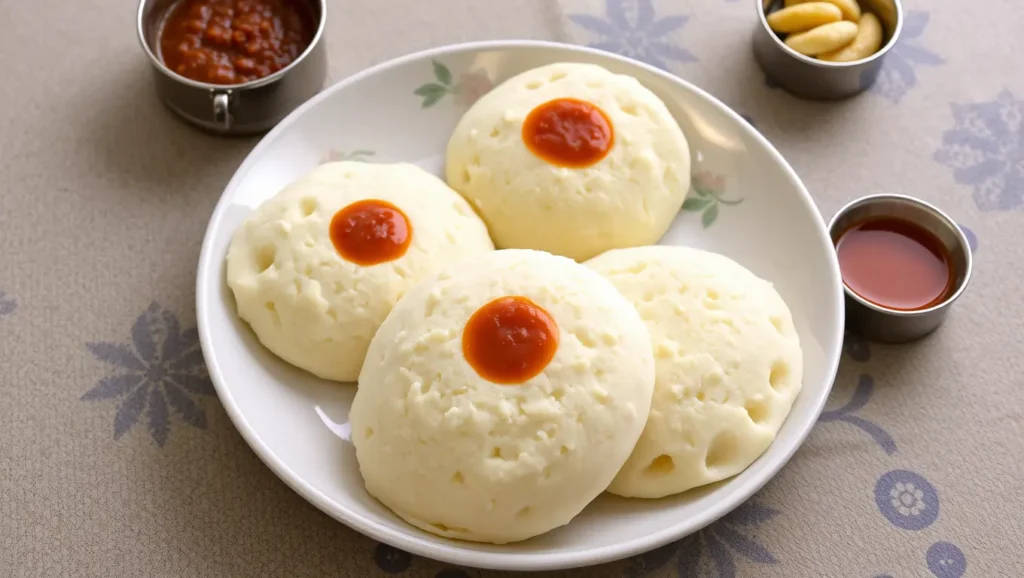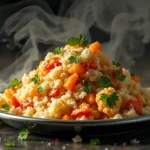Introduction
Idli, a popular South Indian dish, is a staple breakfast food loved by many. These soft, fluffy steamed rice cakes are not only delicious but also easy to digest. If you’ve always wanted to try making idlis at home but felt intimidated, this recipe is perfect for you. Let’s dive into the world of idli-making and discover how simple it can be!
Table of Contents
Ingredients
Here’s what you’ll need to make idlis:
| Ingredient | Quantity |
|---|---|
| Parboiled rice | 2 cups |
| Urad dal (black gram) | 1 cup |
| Fenugreek seeds | 1/4 teaspoon |
| Salt | 1 teaspoon |
| Water | As needed |
Step-by-Step Instructions
1. Soaking the ingredients
- Rinse the rice and urad dal separately until the water runs clear.
- In a large bowl, soak the rice with fenugreek seeds.
- In another bowl, soak the urad dal.
- Add enough water to cover the ingredients by about 2 inches.
- Let them soak for 4-6 hours or overnight.
2. Grinding the batter
- Drain the water from both the rice and urad dal.
- Grind the urad dal first, adding small amounts of water as needed, until smooth and fluffy.
- Transfer the urad dal batter to a large mixing bowl.
- Grind the rice mixture until it reaches a smooth consistency.
- Add the rice batter to the urad dal batter and mix well.
- Add salt and mix thoroughly.
3. Fermentation
- Cover the bowl with a lid or cloth and let it ferment in a warm place for 8–12 hours.
- The batter should rise and become frothy, indicating successful fermentation.
4. Preparing and steaming idlis
- Grease the idli molds with oil.
- Pour the fermented batter into the molds, filling each about 3/4 full.
- Steam the idlis for 10-12 minutes in an idli steamer or pressure cooker.
- Let them cool for a few minutes before removing from the molds.
Serving Suggestions
Serve your homemade idlis hot with coconut chutney and sambar. You can also pair them with tomato chutney or podi (spice powder) for variety.
Nutritional Information
Here’s an approximate nutritional breakdown for one medium-sized Idli:
| Nutrient | Amount |
|---|---|
| Calories | 39 |
| Carbohydrates | 8.5g |
| Protein | 2g |
| Fat | 0.1g |
| Fiber | 0.6g |
Tips for Perfect Idlis
- Use the right rice-to-urad dal ratio for the best texture.
- Don’t overgrind the batter, as it can make the idlis hard.
- Fermentation is key; make sure your batter is well-fermented for soft, fluffy idlis.
- Steam the idlis on medium heat for the best results.
Conclusion
Making idlis at home might seem daunting at first, but with practice, you’ll find it’s quite simple. The key is to be patient during the fermentation process and to use fresh ingredients. Once you master this basic recipe, you can experiment with variations like rava idli or vegetable idli. Happy cooking!
Frequently Asked Questions (FAQs)
What is idli?
Idli is a traditional South Indian breakfast dish. It’s a savory steamed cake made from fermented rice and black lentil batter. Idlis are soft, fluffy, and have a mild, slightly tangy flavor. They’re typically served with coconut chutney and sambar.
What ingredients do I need to make idli?
To make idli, you’ll need:
- Rice (parboiled or idli rice)
- Urad dal (black gram lentils)
- Fenugreek seeds (optional, but adds flavor)
- Salt
- Water
Do I need any special equipment?
While not absolutely necessary, having an idli steamer makes the process much easier. If you don’t have one, you can use a regular steamer with small bowls or even a pressure cooker with idli molds.
How long does it take to make idli?
The actual cooking time for idlis is about 10-15 minutes. However, the batter needs to ferment for about 8-12 hours, so you’ll need to plan ahead.
Can I make the batter without a grinder?
While traditionally idli batter is made using a wet grinder, you can use a regular blender or food processor. The texture might be slightly different, but it will still work.
How do I know when the batter has fermented enough?
The batter should have doubled in volume and have a slightly sour smell. You’ll also see small bubbles on the surface.
My idlis are coming out hard. What am I doing wrong?
Hard idlis can be caused by over-steaming or using too little water in the batter. Make sure your batter has the right consistency (like thick pancake batter) and don’t steam for more than 10-12 minutes.
Can I make idlis without fermenting the batter?
While fermentation is key to the traditional idli texture and flavor, you can make instant idlis using ingredients like semolina or cream of rice. These won’t taste exactly the same but can be a quick alternative.
How do I store leftover idli batter?
You can refrigerate leftover batter for up to a week. Just make sure to bring it to room temperature before using it again.
Are idlis healthy?
Yes, idlis are considered a healthy food option. They’re low in calories, fat-free (when steamed), and provide a good balance of carbohydrates and protein.
Can I freeze idlis?
Yes, you can freeze cooked idlis. Let them cool completely, then place them in an airtight container or freezer bag. They’ll keep for about a month. To reheat, steam them for a few minutes.
What can I serve with idlis?
Traditionally, idlis are served with coconut chutney and sambar. You can also try them with tomato chutney, peanut chutney, or even a spicy lentil soup called rasam.
My idlis are sticking to the molds. How can I prevent this?
Make sure to grease your idli molds with a little oil before adding the batter. Also, let the idlis cool for a few minutes after steaming before trying to remove them.
Can I make idlis with brown rice?
Yes, you can use brown rice to make idlis. They might be a bit denser than traditional white rice idlis, but they’ll be more nutritious.
How do I know if my batter has gone bad?
If your batter smells overly sour or has a strange color, it’s best to discard it. Properly fermented batter should have a pleasant, slightly sour smell.




Pingback: Sambar Recipe: South Indian Vegetarian Curry